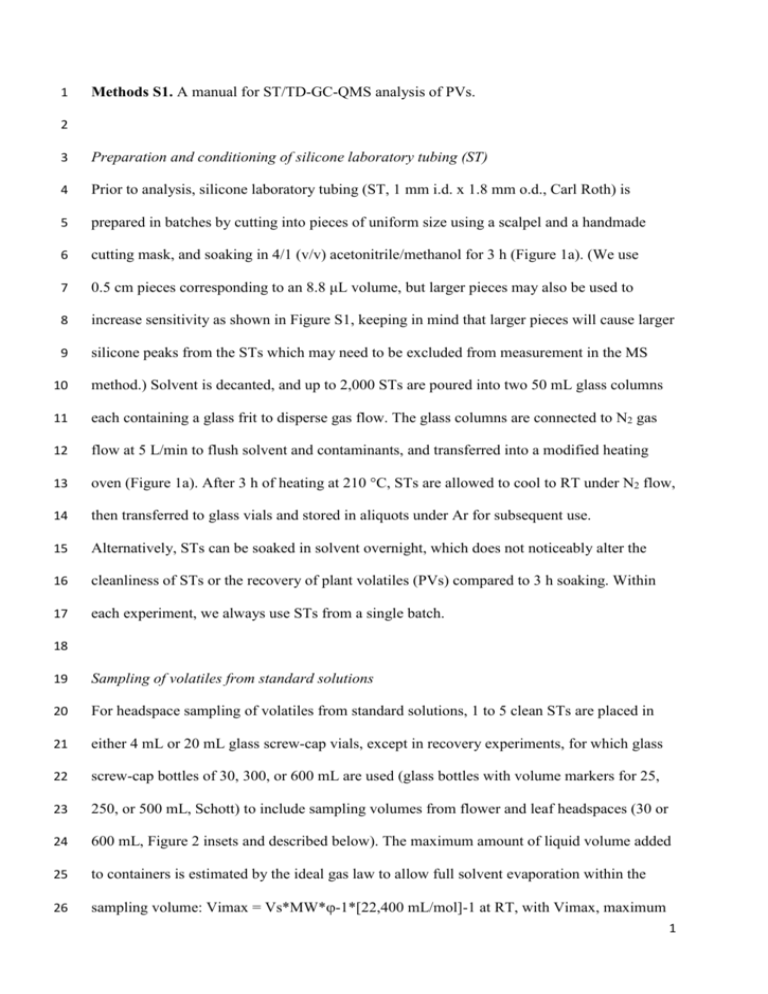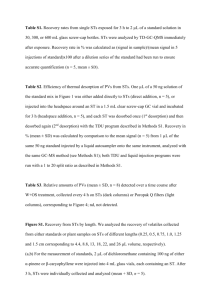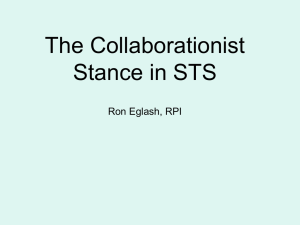tpj12523-sup-0012-MethodS1
advertisement

1 Methods S1. A manual for ST/TD-GC-QMS analysis of PVs. 2 3 Preparation and conditioning of silicone laboratory tubing (ST) 4 Prior to analysis, silicone laboratory tubing (ST, 1 mm i.d. x 1.8 mm o.d., Carl Roth) is 5 prepared in batches by cutting into pieces of uniform size using a scalpel and a handmade 6 cutting mask, and soaking in 4/1 (v/v) acetonitrile/methanol for 3 h (Figure 1a). (We use 7 0.5 cm pieces corresponding to an 8.8 μL volume, but larger pieces may also be used to 8 increase sensitivity as shown in Figure S1, keeping in mind that larger pieces will cause larger 9 silicone peaks from the STs which may need to be excluded from measurement in the MS 10 method.) Solvent is decanted, and up to 2,000 STs are poured into two 50 mL glass columns 11 each containing a glass frit to disperse gas flow. The glass columns are connected to N2 gas 12 flow at 5 L/min to flush solvent and contaminants, and transferred into a modified heating 13 oven (Figure 1a). After 3 h of heating at 210 °C, STs are allowed to cool to RT under N2 flow, 14 then transferred to glass vials and stored in aliquots under Ar for subsequent use. 15 Alternatively, STs can be soaked in solvent overnight, which does not noticeably alter the 16 cleanliness of STs or the recovery of plant volatiles (PVs) compared to 3 h soaking. Within 17 each experiment, we always use STs from a single batch. 18 19 Sampling of volatiles from standard solutions 20 For headspace sampling of volatiles from standard solutions, 1 to 5 clean STs are placed in 21 either 4 mL or 20 mL glass screw-cap vials, except in recovery experiments, for which glass 22 screw-cap bottles of 30, 300, or 600 mL are used (glass bottles with volume markers for 25, 23 250, or 500 mL, Schott) to include sampling volumes from flower and leaf headspaces (30 or 24 600 mL, Figure 2 insets and described below). The maximum amount of liquid volume added 25 to containers is estimated by the ideal gas law to allow full solvent evaporation within the 26 sampling volume: Vimax = Vs*MW*-1*[22,400 mL/mol]-1 at RT, with Vimax, maximum 1 27 injection volume; Vs, sampling volume, MW, molecular weight of the solvent; and , solvent 28 density. We add different amounts of standard dissolved in 1 to 4 µL of dichloromethane 29 (maximum 2 µL in 4 mL vials and 4 µL in 20 mL vials) to the glass containers with STs, 30 being careful to add solvent to the wall of the vial and not directly to any STs. Containers are 31 closed immediately and STs are usually transferred after 3 h to clean 1.5 mL screw-cap glass 32 vials and stored at -20 °C for subsequent TD-GC-QMS analysis. Although dichloromethane 33 and other nonpolar solvents are known to swell the PDMS matrix (Lee et al., 2003), we obtain 34 80-90% recovery of PVs from STs when a standard in dichloromethane is either directly 35 applied, or added into the headspace of 1.5 mL vials, compared to injection of the same 36 standard by a liquid autosampler (Table S2). Thus the solvent does not greatly interfere with 37 the absorption of PVs in the standard by STs, and we obtain low limits of detection 38 comparable to liquid injection of standards (LoDs Figure 1 C, Figures S4, S5). 39 40 Sampling of PVs from leaf and flower headspaces with STs 41 Poly(ethylene terephthalate) (PET) containers (Stewart-Jones and Poppy, 2006) are used to 42 enclose leaves and flowers for headspace sampling with STs (see insets, Figure 2). For leaves, 43 we use 300 mL PET cups with detachable lids (Iso-pack, total volume of full cup and lid is 44 600 mL). The lids have a hole in the center with a diameter of 2.5 cm, which is sufficient to 45 pass over a gently rolled leaf without causing damage; additionally, we make holes of ca. 46 1 cm diameter at the base of the cup to allow transpiration and airflow across the headspace, 47 as well as easy addition and removal of STs over time course measurements. For leaf 48 headspace samples, a similar, fully expanded, mature, non-senescent stem leaf is chosen from 49 each plant for treatment and volatile sampling (Halitschke et al., 2000). For flowers, 30 mL 50 PET soufflé cups (Solo) are used. We cut one hole at the edge of the cup’s base, and another, 51 in the opposite edge of the lid, sufficiently large to slip over a flower. STs can be easily 52 inserted and removed through the hole in the base of the cup. As for containers used with 2 53 leaves, the holes are offset such that PVs must diffuse from the open flower into the container 54 before diffusing out. Flowers are enclosed before opening, on the first night of opening 55 (Kessler et al., 2010). STs in otherwise empty trapping containers dispersed among plants are 56 used to monitor background levels of PVs. 57 To measure PVs released after damage, leaves are treated with 6 rows of wounds from 58 a pattern wheel as a standardized damage treatment. To measure herbivore-induced PVs, 59 20 µL of Manduca sexta oral secretions diluted 1:5 with distilled water are added to wounds 60 (W+OS) to mimic feeding by this solanaceous specialist, as described previously (Schittko et 61 al., 2001; Schuman et al., 2012). 62 To reveal differences among plants in the jasmonate-mediated emission of PVs, one 63 leaf per plant is sprayed with the synthetic JA-Ile analogue I-indanoyl-Ile-Me (Lauchli and 64 Boland, 2003; Svoboda and Boland, 2010) at a concentration of 100 μM in 0.8% EtOH. 65 Leaves are allowed to dry for 1 h after spraying and then enclosed in PET containers and 66 exposed to STs as described above. 67 68 TD-GC-QMS analysis 69 TD-GC-QMS analysis is performed on a TD-20 thermal desorption unit (Shimadzu) 70 connected to a quadrupole GC-MS-QP2010Ultra (Shimadzu). Individual STs are placed in 71 89 mm glass TD tubes (Supelco) and desorbed under a stream of nitrogen at 60 mL min-1 for 72 8 min at 200 °C; after desorption, less than 0.2% of the original signal remains on STs 73 (Table S2). All substances desorbed from the ST are cryo-focused at -20 °C onto a Tenax® 74 adsorbent trap in front of the column. After desorption, the Tenax® trap is heated to 230 °C 75 within 10 s, and analytes are injected using a 1 to 20 split ratio onto an Rtx-5MS column 76 (30 m long, 0.25 mm i.d., 0.25 µm film thickness; Restek) with He as the carrier gas at a 77 constant linear velocity of 40 cm s-1. The TD-GC interface is held at 230 °C. We use two 78 different GC oven gradients for the profiling of leaf and flower headspaces. For leaf samples, 3 79 the oven is held at 40 °C for 5 min, then ramped to 185 °C at 5.0 °C min-1, and finally to 80 280 °C at 30 °C min-1, where it was held for 0.83 min. For analysis of benzyl acetone 81 emission from flower samples, the oven is held at 60 °C for 1 min, then ramped to 150 °C at 82 10 °C min-1, and finally to 250 °C at 30 °C min-1. Electron impact (EI) spectra are recorded at 83 70 eV in scan mode from 33 to 400 m/z using a scan speed of 2,000 Da s-1.The transfer line is 84 held at 240 °C and the ion source at 220 °C. Data processing against our reference compounds 85 (Table 1) is performed using the Shimadzu GCMS solutions software (v2.72). Compounds in 86 Table 1 were identified by comparison of spectra and Kovats retention indices to libraries and, 87 when possible, by comparison to pure standards. 88 89 Comparison of PV measurements from ST vs. Poropak Q sampling 90 Leaf positions +1 and +2 (the two youngest fully-expanded leaves) are treated with W+OS 91 and enclosed in PET containers as described above. One container is connected to a Poropak 92 Q filter attached to a vacuum manifold pulling air through the headspace at 300 mL/min, and 93 the other recieves a 0.5 cm ST. Headspace samples are collected every 4 h by exchanging 94 Poropak Q filters and STs. Background levels of PVs are monitored using empty PET 95 containers distributed among plants and either connected to Poropak Q filters attached to a 96 vacuum manifold pulling air through the headspace at 300 mL/min, or containing a 0.5 cm ST 97 (n = 3 background monitors of each type, sample n given in Figure 4). 98 99 STs are analyzed by TD-GC-QMS as described above. Poropak Q filters are spiked with 320 ng tetralin (Sigma-Aldrich) as an elution standard, eluted with 250 μL 100 dichloromethane into a 1.5 mL clear glass screw-cap GC vial containing a 250 μL microinsert 101 as previously described (Halitschke et al., 2000; Schuman et al., 2012), and analyzed on the 102 same instrument as described for STs, except that a liquid autosampler (AOC-20i, Shimadzu) 103 injects 1 µL of sample, splitless, into the GC inlet held at 230 °C. Both ST and Poropak 104 samples are analyzed using the 35 min program described above. Results are analyzed using 4 105 the reference list in Table 1. Peaks found in the background controls are used to set a 106 threshold for quantification prior to statistical analysis: within each sampling interval, for each 107 compound processed, the maximum peak area measured in the background controls is 108 subtracted from the peak areas of samples; any sample peak areas which are less than the 109 maximum in the background controls are set to zero. Background-corrected peak areas from 110 Poropak Q samples are additionally normalized to the elution internal standard, tetralin, and 111 expressed as percentage tetralin peak area (Gaquerel et al., 2009; Schuman et al., 2009). 112 Statistical analyses are described in the Experimental procedures section of the main text. 113 114 Supporting References 115 116 117 118 Gaquerel E, Weinhold A, Baldwin IT (2009) Molecular interactions between the specialist herbivore Manduca sexta (Lepidoptera, Sphigidae) and its natural host Nicotiana attenuata. VIII. An unbiased GCxGC-ToFMS analysis of the plant’s elicited volatile emissions. Plant Physiol, 149, 1408-1423. 119 120 121 Halitschke R, Keßler A, Kahl J, Lorenz A, Baldwin IT (2000) Ecophysiological comparison of direct and indirect defenses in Nicotiana attenuata. Oecologia, 124, 408417. 122 123 Lee JN, Park C, Whitesides GM (2003) Solvent compatibility of poly(dimethylsiloxane)based microfluidic devices. Anal Chem, 75, 6544–6554. 124 125 Kessler D, Diezel C, Baldwin IT (2010) Changing pollinators as a means of escaping herbivores. Curr Biol, 20, 237-242. 126 127 128 Schuman MC, Barthel K, Baldwin IT (2012) Herbivory-induced volatiles function as defenses increasing fitness of the native plant Nicotiana attenuata in nature. eLife, 1, e00007. 129 130 131 Schuman MC, Heinzel N, Gaquerel E, Svatos A, Baldwin IT (2009) Polymorphism in jasmonate signaling partially accounts for the variety of volatiles produced by Nicotiana attenuata plants in a native population. New Phytol, 183, 1134-1148. 132 133 Stewart-Jones A, Poppy GM (2006) Comparison of glass vessels and plastic bags for enclosing living plant parts for headspace analysis. J Chem Ecol, 32, 845-864. 5






